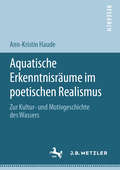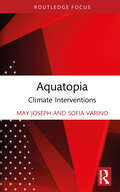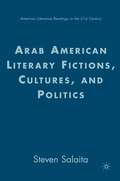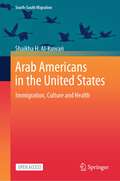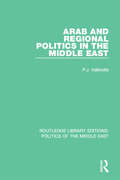- Table View
- List View
Aquaculture: Models And Economics
by Upton HatchPresenting state-of-the-art research on the economics of producing and marketing aquacultural products, this volume addresses critical issues concerning profitability, market acceptance, and economic modeling of various aquacultural products. Research approaches range from firm-level bioeconomic modelling to market-level econometric modelling of industry growth and product substitution. The studies highlight the institutional structures and public policy issues that will shape growth and development of aquaculture into the twenty-first century, including trade policies, food safety, and environmental quality.
Aquaculture: Models And Economics
by Upton HatchPresenting state-of-the-art research on the economics of producing and marketing aquacultural products, this volume addresses critical issues concerning profitability, market acceptance, and economic modeling of various aquacultural products. Research approaches range from firm-level bioeconomic modelling to market-level econometric modelling of industry growth and product substitution. The studies highlight the institutional structures and public policy issues that will shape growth and development of aquaculture into the twenty-first century, including trade policies, food safety, and environmental quality.
Aquaculture Development In Less Developed Countries: Social, Economic, And Political Problems
by Leah SmithAquaculture may not be the panacea for the world's food problems, but It has the potential to make important contributions to diet and incomes in some areas. This book, intended to improve planning for further development of aquaculture, examines the factors that can determine the success or failure of aquaculture projects in developing countries.
Aquaculture Development In Less Developed Countries: Social, Economic, And Political Problems
by Leah SmithAquaculture may not be the panacea for the world's food problems, but It has the potential to make important contributions to diet and incomes in some areas. This book, intended to improve planning for further development of aquaculture, examines the factors that can determine the success or failure of aquaculture projects in developing countries.
Aquaculture In America: The Role Of Science, Government, And The Entrepreneur
by Art TiddensTiddens' job is to track (one might suspect, to advance) the financial prospects for American companies cultivating aquatic plants and animals. He surveys the support currently available from state and federal governments and scientific institutions and urges that more is needed.
Aquaculture In America: The Role Of Science, Government, And The Entrepreneur
by Art TiddensTiddens' job is to track (one might suspect, to advance) the financial prospects for American companies cultivating aquatic plants and animals. He surveys the support currently available from state and federal governments and scientific institutions and urges that more is needed.
Aquatische Erkenntnisräume im poetischen Realismus: Zur Kultur- und Motivgeschichte des Wassers
by Ann-Kristin HaudeAnn-Kristin Haude spürt hier der Komplexität des Wasserraums nach, indem sie 14 Prosatexte aus der deutschsprachigen Literatur der zweiten Hälfte des 19. Jahrhunderts mit der Zielsetzung untersucht, die literarische Architektur der Relationierung zwischen Wasserräumen und Wahrnehmung, Erkenntnis und Wissen zu konkretisieren. Die Analysen dokumentieren, dass sich der erkenntnistheoretische Wandel vom Idealismus zum Positivismus an Wasserräumen zeigt. Zugleich konturiert die Arbeit den Wasserraum als einen Chronotopos und liefert einen Beitrag zur im Medium der Literatur konstruierten Kultur- und Motivgeschichte des Wassers.
Aquatopia: Climate Interventions (Critical Climate Studies)
by May Joseph Sofia VarinoAquatopia documents Harmattan Theater’s ecological interventions and traces its engagements with water-bound landscapes, colonial histories, climate change, and public space across New York City, Venice, Amsterdam, Lisbon, and Cochin. The volume uses Harmattan’s site-specific performances as a point of departure to consider climate change and rising sea levels as geographical, ecological, and urban phenomena. Instead of a collection of flat, static surfaces, the Aquatopia atlas is animated by a disorienting, anti-mapping strategy, producing a deterritorialized, nomadic, fluid atlas unfolding in real time as an archive of climate change in multidimensional, active space. The book is designed for pedagogical access, with interludes that consolidate the learning outcomes of the experimental theory animating each site-specific performance. Accompanied by close descriptions of five performances and supplemented by digital documentation available online, this volume intervenes in discussions on climate change, urbanism, and postcolonization/decolonialization, and contributes to interdisciplinary studies of ecology and environmental politics, postcolonial/decolonial theories and practices, performance studies and aesthetics, in particular public art, and performance as research.
Aquatopia: Climate Interventions (Critical Climate Studies)
by May Joseph Sofia VarinoAquatopia documents Harmattan Theater’s ecological interventions and traces its engagements with water-bound landscapes, colonial histories, climate change, and public space across New York City, Venice, Amsterdam, Lisbon, and Cochin. The volume uses Harmattan’s site-specific performances as a point of departure to consider climate change and rising sea levels as geographical, ecological, and urban phenomena. Instead of a collection of flat, static surfaces, the Aquatopia atlas is animated by a disorienting, anti-mapping strategy, producing a deterritorialized, nomadic, fluid atlas unfolding in real time as an archive of climate change in multidimensional, active space. The book is designed for pedagogical access, with interludes that consolidate the learning outcomes of the experimental theory animating each site-specific performance. Accompanied by close descriptions of five performances and supplemented by digital documentation available online, this volume intervenes in discussions on climate change, urbanism, and postcolonization/decolonialization, and contributes to interdisciplinary studies of ecology and environmental politics, postcolonial/decolonial theories and practices, performance studies and aesthetics, in particular public art, and performance as research.
The Aquitanian Kyrie Repertory of the Tenth and Eleventh Centuries
by Richard Crocker David BjorkThis book was published in 2003. One of the most important but least studied of medieval chant repertories is that of the Kyrie. With their Latin texts, Kyrie melodies represented musical ambitions manifested alongside of and subsequent to Gregorian chant - ambitions which achieved stylistic and formal distinction. This study illuminates those features of the early Kyrie that give it its distinctive character and set it apart not only from Gregorian chant but also from other types of medieval chant. The repertory focused on in this book is a group of 22 West Frankish sources which are believed to have originated in several Aquitanian locations. The tradition represented by these manuscripts and their repertory of Kyrie melodies can be followed across a century and a half, from 950 to 1100. The Aquitanian manuscript tradition is significant because these sources represent by far the largest group of closely inter-related musical sources from the period, and the musical notation gives reliable indication of pitch up to a century earlier than other manuscripts of the time. By incorporating both a detailed musical study and transcriptions of these sources this book should be of interest to those who are concerned with the construction of these pieces as well as to those who wish to appreciate them, or even perform them.
The Aquitanian Kyrie Repertory of the Tenth and Eleventh Centuries
by Richard Crocker David BjorkThis book was published in 2003. One of the most important but least studied of medieval chant repertories is that of the Kyrie. With their Latin texts, Kyrie melodies represented musical ambitions manifested alongside of and subsequent to Gregorian chant - ambitions which achieved stylistic and formal distinction. This study illuminates those features of the early Kyrie that give it its distinctive character and set it apart not only from Gregorian chant but also from other types of medieval chant. The repertory focused on in this book is a group of 22 West Frankish sources which are believed to have originated in several Aquitanian locations. The tradition represented by these manuscripts and their repertory of Kyrie melodies can be followed across a century and a half, from 950 to 1100. The Aquitanian manuscript tradition is significant because these sources represent by far the largest group of closely inter-related musical sources from the period, and the musical notation gives reliable indication of pitch up to a century earlier than other manuscripts of the time. By incorporating both a detailed musical study and transcriptions of these sources this book should be of interest to those who are concerned with the construction of these pieces as well as to those who wish to appreciate them, or even perform them.
The Arab-african Connection: Political And Economic Realities
by Victor T Le Vine Timothy W LukeBetween June 1967 and the end of 1973, most independent Black African states abandoned their neutral position in the Middle East conflict, cut their ties with Israel, and gave full support to the political aims of the Arab states. Since the beginning of 1974, however, and despite attempts by the Arabs to shield their new allies from the adverse effects of the 1973-74 world oil and economic crises, the alliance has begun to fragment as the African states become transformed from partners to clients and dependents of the Arabs. This study examines the roots of the African conversion, the nature of the evolving relationship between the African and Arab states, and the reasons—economic and political—for the transformation of the alliance. Basic to that transformation, the authors argue, is a fundamental change in the international status and power of the Arab states, a change that has led them to cast their lot with the industrialized "First World" rather than with the poorer, less developed countries.
The Arab-african Connection: Political And Economic Realities
by Victor T Le Vine Timothy W LukeBetween June 1967 and the end of 1973, most independent Black African states abandoned their neutral position in the Middle East conflict, cut their ties with Israel, and gave full support to the political aims of the Arab states. Since the beginning of 1974, however, and despite attempts by the Arabs to shield their new allies from the adverse effects of the 1973-74 world oil and economic crises, the alliance has begun to fragment as the African states become transformed from partners to clients and dependents of the Arabs. This study examines the roots of the African conversion, the nature of the evolving relationship between the African and Arab states, and the reasons—economic and political—for the transformation of the alliance. Basic to that transformation, the authors argue, is a fundamental change in the international status and power of the Arab states, a change that has led them to cast their lot with the industrialized "First World" rather than with the poorer, less developed countries.
An Arab Ambassador in the Mediterranean World: The Travels of Muhammad ibn ‘Uthmān al-Miknāsī, 1779-1788 (Culture and Civilization in the Middle East)
by Nabil MatarThis book provides translated selections from the writings of Muhammad Ibn Othman al-Miknasi (d. 1799). The only writings by an Arab-Muslim in the pre-modern period that present a comparative perspective, his travelogues provide unique insight with in to Christendom and Islam. Translating excerpts from his three travelogues, this book tells the story of al-Miknasi’s travels from 1779-1788. As an ambassador, al-Miknasi was privy to court life, government offices and religious buildings, and he provides detailed accounts of cities, people, customs, ransom negotiations, historical events and political institutions. Including descriptions of Europeans, Arabs, Turks, Christians (both European and Eastern), Muslims, Jews, and (American) Indians in the last quarter of the eighteenth century, An Arab Ambassador in the Mediterranean World explores how the most travelled Muslim writer of the pre-modern period saw the world: from Spain to Arabia and from Morocco to Turkey, with second-hand information about the New World. Supplemented with extensive notes detailing the historic and political relevance of the translations, this book is of interest to researchers and scholars of Mediterranean History, Ottoman Studies and Muslim-Christian relations.
An Arab Ambassador in the Mediterranean World: The Travels of Muhammad ibn ‘Uthmān al-Miknāsī, 1779-1788 (Culture and Civilization in the Middle East)
by Nabil MatarThis book provides translated selections from the writings of Muhammad Ibn Othman al-Miknasi (d. 1799). The only writings by an Arab-Muslim in the pre-modern period that present a comparative perspective, his travelogues provide unique insight with in to Christendom and Islam. Translating excerpts from his three travelogues, this book tells the story of al-Miknasi’s travels from 1779-1788. As an ambassador, al-Miknasi was privy to court life, government offices and religious buildings, and he provides detailed accounts of cities, people, customs, ransom negotiations, historical events and political institutions. Including descriptions of Europeans, Arabs, Turks, Christians (both European and Eastern), Muslims, Jews, and (American) Indians in the last quarter of the eighteenth century, An Arab Ambassador in the Mediterranean World explores how the most travelled Muslim writer of the pre-modern period saw the world: from Spain to Arabia and from Morocco to Turkey, with second-hand information about the New World. Supplemented with extensive notes detailing the historic and political relevance of the translations, this book is of interest to researchers and scholars of Mediterranean History, Ottoman Studies and Muslim-Christian relations.
Arab American Aesthetics: Literature, Material Culture, Film, and Theatre (Routledge Studies on Middle Eastern Diasporas)
by Therí A. PickensArab American Aesthetics enlists a wide range of voices to explore, if not tentatively define, what could constitute Arab American aesthetics in literature, material culture, film, and theatre. This book seeks to unsettle current conversations within Arab American Studies that neglect aesthetics as a set of choices and constraints. Rather than divorce aesthetics from politics, the book sutures the two more closely together by challenging the causal relationship so often attributed to them. The conversations include formal choices, but also extend to the broad idea of what makes a work distinctly Arab American. That is, what about its beauty, ugliness, sublimity, or humor is explicitly tied to it as part of a tradition of Arab American arts? The book opens up the ways that we discuss Arab American literary and fine arts, so that we understand how Arab American identity and experience begets Arab American artistic enterprise. Split into three sections, the first offers a set of theoretical propositions for understanding aesthetics that traverse Arab American cultural production. The second section focuses on material culture as a way to think through the creation of objects as an aesthetic enterprise. The final section looks at narratives in theatre and how the impact of such a medium has the potential to recreate in both senses of the word: play and invention. By shifting the conversation from identity politics to the relationship between politics and aesthetics, this book provides an important contribution to Arab American studies. It will also appeal to students and scholars of ethnic studies, museum studies, and cultural studies.
Arab American Aesthetics: Literature, Material Culture, Film, and Theatre (Routledge Studies on Middle Eastern Diasporas)
Arab American Aesthetics enlists a wide range of voices to explore, if not tentatively define, what could constitute Arab American aesthetics in literature, material culture, film, and theatre. This book seeks to unsettle current conversations within Arab American Studies that neglect aesthetics as a set of choices and constraints. Rather than divorce aesthetics from politics, the book sutures the two more closely together by challenging the causal relationship so often attributed to them. The conversations include formal choices, but also extend to the broad idea of what makes a work distinctly Arab American. That is, what about its beauty, ugliness, sublimity, or humor is explicitly tied to it as part of a tradition of Arab American arts? The book opens up the ways that we discuss Arab American literary and fine arts, so that we understand how Arab American identity and experience begets Arab American artistic enterprise. Split into three sections, the first offers a set of theoretical propositions for understanding aesthetics that traverse Arab American cultural production. The second section focuses on material culture as a way to think through the creation of objects as an aesthetic enterprise. The final section looks at narratives in theatre and how the impact of such a medium has the potential to recreate in both senses of the word: play and invention. By shifting the conversation from identity politics to the relationship between politics and aesthetics, this book provides an important contribution to Arab American studies. It will also appeal to students and scholars of ethnic studies, museum studies, and cultural studies.
Arab American Literary Fictions, Cultures, and Politics (American Literature Readings in the 21st Century)
by S. SalaitaN.B. this is a 'Palgrave to Order' title. Stock of this book requires shipment from overseas. It will be delivered to you within 12 weeks. Using literary and social analysis, this book examines a range of modern Arab American literary fiction and illustrates how socio-political phenomena have affected the development of the Arab American novel.
Arab-American Women's Writing and Performance: Orientalism, Race and the Idea of the Arabian Nights (International Library of Cultural Studies)
by Somaya Sami SabryThe public image of Arabs in America has been radically affected by the 'war on terror'. But stereotypes of Arabs, manifested for instance in Orientalist representations of Sheherazade and the Arabian Nights in Hollywood and American popular culture, have prevailed for much longer. Here Somaya Sabry traces the powerful effects of racial discourse and nineteenth- and twentieth-century American Orientalism on the Arab-American experience, setting the stage for a discussion of contemporary Arab-American women's responses. She shows how Arab-American women writers and performers confront and subvert racial stereotypes in this charged context, which is further complicated today by hostility towards Arabs in post-9/11 America.How do Arab-American women writers and performers interrogate central tropes in the current polarized and historical moment? Sabry suggests that the figure of Sheherazade and the idea of the Arabian Nights, with their themes of transformation and change, offer a common cultural space for the exploration and reinterpretation of these stereotypes across the work of contemporary writers and performers-from Diana Abu-Jaber's Crescent to Mohja Kahf's E-Mails from Scheherazad, from Laila Farah's Living in the Hyphen-Nation to Maysoon Zayid's stand-up comedy. Through close readings and critical analyses Sabry reveals how each of these writers and performers engage in varying ways with Sheherazadian narrative and orality, and thus forge a location for cultural translation and negotiation-interrogating stereotypes of oppressed Muslim/Arab women at the same time that they navigate belonging and identity in a hostile/ambivalent environment. Combining literary, cultural and political analysis, and shedding new light on Arab-American women's negotiations of identity, this book will be indispensable for all those interested in the Arab-American world, American ethnic studies and race, as well as diaspora studies, women's studies, literature, cultural studies and performance studies.
Arab American Youth: Discrimination, Development, and Educational Practice and Policy (Advancing Responsible Adolescent Development)
by Rhonda TabbahThis book examines the implications of discrimination in Arab American youth with a focus on K-12 school systems. It begins with an introduction to Arab American youth and their experiences in the education system. The book follows with an overview regarding historical contributions of discrimination and the history of discrimination against Arabs in America, including the education system. It then presents relevant theoretical perspectives regarding discrimination and developmental processes. The book examines research specific to Arab American youth, identifies research limitations, and provides strategies on how to strengthen methodological approaches to better inform research, practice, and policy. It concludes by offering strategies for improving educational practice and policy and recommendations for interventions designed to enhance developmental health of Arab American youth in schools.Key areas of coverage include:Arab American youth, development, and discrimination in America.Discrimination in the K-12 educational system.Self-concept, ethnic identity, well-being and discrimination among Arab American youth.Arab American Youth is an essential resource for practitioners, researchers, educators, and related professionals as well as graduate students in school psychology, educational psychology, education, and related disciplines.______________________________________________________________________Dr. Tabbah has written a book that is well overdue … she provides a blueprint for moving forward in education as well as in policy development that can be transformative for Arab-American youth. Antoinette Miranda, Professor of School Psychology, The Ohio State University This book is a valuable contribution given the nascent literature on the experiences of Arab youth and the significant impact of discrimination on their schooling. Desiree Vega, Associate Professor of School Psychology, University of Arizona
Arab Americans in the United States: Immigration, Culture and Health (International Perspectives on Migration)
by Shaikha H. Al-KuwariThis open access book provides a unique perspective on the relationship between immigration, culture, and health. It presents a cross-cultural perspective between culture and illness. It touches upon identity struggles, the notion of not feeling “safe, understood, accepted,” and its relation to Arab American health. The book provides a comprehensive review of the history of Muslims in America and discusses better healthcare services for chronic illness—diabetes. It provides an ethnographic framework for building cultural belief models of illness, which helps study any illness among any population. It is a must-read for everyone interested in understanding the relationship among culture, health, and immigration, as well as the importance of building cultural belief models of illness and their possible impact on providing better healthcare services. The book is of interest to scholars, caregivers, and those living with diabetes.
Arab and Jewish Immigrants in Latin America: Images and Realities
by Ignacio Klich Jeffrey LesserThis collection of essays addresses various aspects of Arab and Jewish immigration and acculturation in Latin America. The volume examines how the Latin American elites who were keen to change their countries' ethnic mix felt threatened by the arrival of Arabs and Jews.
Arab and Jewish Immigrants in Latin America: Images and Realities
by Ignacio Klich Jeffrey LesserThis collection of essays addresses various aspects of Arab and Jewish immigration and acculturation in Latin America. The volume examines how the Latin American elites who were keen to change their countries' ethnic mix felt threatened by the arrival of Arabs and Jews.
Arab and Regional Politics in the Middle East (Routledge Library Editions: Politics of the Middle East)
by P.J. VatikiotisThree main themes are explored in this book, first published in 1984: the first is the problem of religion and politics as a major and long-standing preoccupation of Middle-easterners or Arab Muslims themselves; the second is that of the conflict-ridden inter-Arab and regional politics, approached largely from a local rather than an international perspective; the third deals with Egypt. The book also enquires into the nature of rule and regimes in the Middle East, the basis of authority and the arrangements for the organisation, exercise and use of power. Drawing examples from Egypt and the Fertile Crescent, the emphasis is on the relation between tradition and politics, historical evolution and state policy, domestic factors and external constraints.
Arab and Regional Politics in the Middle East (Routledge Library Editions: Politics of the Middle East)
by P.J. VatikiotisThree main themes are explored in this book, first published in 1984: the first is the problem of religion and politics as a major and long-standing preoccupation of Middle-easterners or Arab Muslims themselves; the second is that of the conflict-ridden inter-Arab and regional politics, approached largely from a local rather than an international perspective; the third deals with Egypt. The book also enquires into the nature of rule and regimes in the Middle East, the basis of authority and the arrangements for the organisation, exercise and use of power. Drawing examples from Egypt and the Fertile Crescent, the emphasis is on the relation between tradition and politics, historical evolution and state policy, domestic factors and external constraints.



